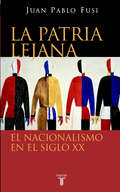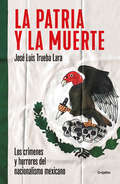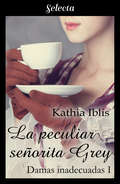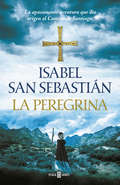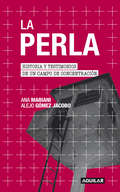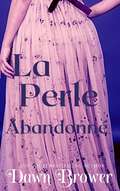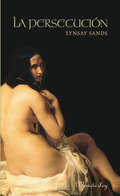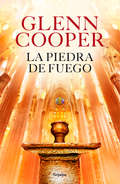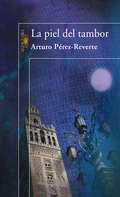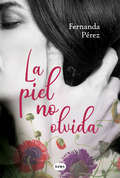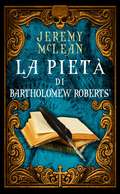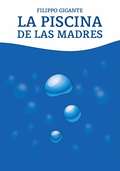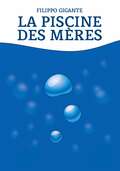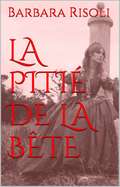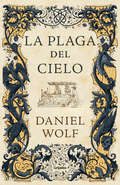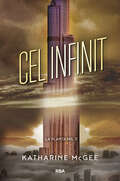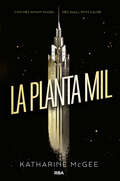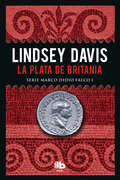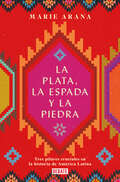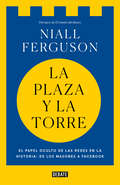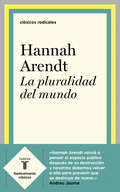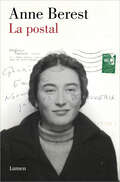- Table View
- List View
La patria lejana: El nacionalismo en el siglo XX (Taurus Historia Ser.)
by Juan Pablo FusiEl historiador Juan Pablo Fusi analiza en el nacionalismo como realidad histórica fundamental para comprender el siglo XX. El nacionalismo no es un problema (y desde luego no es un problema sólo español): es una realidad histórica. En los siglos XIX y XX ha sido una fuerza capaz de transformar el mundo aún más poderosa que los cambios económicos, los conflictos sociales e incluso el progreso científico y tecnológico. Ha sido, y sigue siendo, una estrategia de poder. El núcleo de este ensayo es la secuencia del nacionalismo en el siglo XX: la etapa de plenitud; su fascistización en el período de entreguerras; el desprestigio de estos movimientos a partir de 1945; el nacionalismo como liberación nacional; el resurgir etno-nacionalista desde 1960; el triunfo de las nacionalidades y la reaparición de guerras nacionalistas en la Europa del este tras el colapso del comunismo en 1989.
La patria y la muerte: Los crímenes y horrores del nacionalismo mexicano
by José Luis Trueba LaraTras la brutalidad de la Revolución, los sobrevivientes necesitaban una esperanza y el nacionalismo se la dio. Pero a un costo altísimo: muerte y mentira. El discurso oficial asienta que el amor a México es obligatorio, eterno, inamovible y perfecto. No es así. El actual nacionalismo mexicano es una invención posrevolucionaria, fomentado para crear un sentido de unidad y de propósito tras la matanza vivida entre 1910 y 1917. Y eso es lo de menos. Ese patriotismo fue una excusa para perpetrar algunas de las peores atrocidades que se han cometido en suelo patrio. Discriminación, racismo, clasismo y exclusión son sus caras menos oscuras. Las peores se llaman odio, expulsión, destierro, asesinato y genocidio. Esta obra señala el negro camino que ha seguido la devoción hacia México y la impunidad de la que ha gozado. Hoy, como nunca, se vuelve necesario reflexionar sobre el tema de esta obra: ¿a qué deliriosnos puede llevar el nacionalismo desatado?
La peculiar señorita Grey (Damas inadecuadas #Volumen 1)
by Kathia IblisPrimera entrega de la serie «Damas inadecuadas» de Kathia Iblis. Una historia de amor ligera, dinámica y entretenida, que cuenta entre sus páginas con un un romance victoriano, una protagonista peculiar y un secreto. La señorita Calpurnia Gwendolyn Grey, Gigi para sus conocidos, es una joven heredera que tan solo espera cumplir sus veinticinco años para recibir la dote que sus padres le dejaron como herencia. Ella anhela casarse, pero siente que sus cicatrices y su peculiar conducta la condenan a una eterna soltería, pues ningún partido decente se fija en ella. Lord Alasdair Leonidas Saint Leger, vizconde de Doneraile, necesita una esposa adecuada. Sin embargo, desde el mismo instante en que su camino se cruza con el de una extraña joven de guantes, su corazón entra en batalla con su mente, pues una dama tan peculiar jamás sería aceptada para ostentar el título de vizcondesa. Circunstancias y enemigos del pasado entrelazarán sus caminos, lo que forjará un lazo entre ellos que los empujará a un amor que, si se atreven, podría ser inquebrantable.
La peregrina
by Isabel San SebastiánLa apasionante aventura que dio origen al Camino de Santiago. Isabel San Sebastián vuelve a la novela histórica con una nueva aventura de Alana de Coaña, La visigoda, su personaje más famoso, y nos ofrece un viaje fascinante al origen de un camino que cambió la historia del mundo. Año 827. En su pequeña corte guerrera, Alfonso II el Casto, rey de Asturias y aliado de Carlomagno, recibe una extraordinaria noticia: en un bosque próximo a Iria Flavia, allá donde termina el mundo, han aparecido los restos del apóstol Santiago. ¿Es posible tal prodigio? El rey decide acudir al lugar, a fin de aclarar el misterio. En la comitiva marchan nobles enredados en intrigas, fieros soldados, cautivos sarracenos, monjes custodios de turbios secretos... un fiel reflejo de ese tiempo turbulento, cuyo epicentro es un rey determinado a salvar su reino. Y junto a él cabalga Alana, con la esperanza de encontrar a su hijo desaparecido y el desafío de narrar, sin saberlo, la primera peregrinación jacobea de la Historia. «Me llamo Alana. Por mis venas corre sangre astur y sangre goda. Sirvo a don Alfonso el Magno, rey de Asturias. Mis ojos cansados han visto horrores sin cuento, pero antes de cerrarse para siempre tal vez puedan contemplar el lugar donde reposa el apóstol Santiago» Unas reliquias misteriosas, un destino incierto, un viaje que sentará los cimientos del camino más famoso de la cristiandad. Nota de la autora:La peregrina narra la historia real de la peregrinación que realizó Alfonso II en el siglo IX desde la capital del reino de Asturias hasta un bosque perdido en el Finis Terrae, en pos de las legendarias reliquias del apóstol Santiago. Se dice que dicho viaje sentó las bases del actual Camino de Santiago. A partir de una labor de documentaciónexhaustiva y de mi cariño sincero por las tierras asturianas y gallegas, he novelado esa aventura en forma de diario, desde el punto de vista de una mujer, Alana de Coaña. Pero, además, he considerado de interés para el lector aficionado a la Historia hacerle partícipe de algunos datos reales contrastados, así como del origen de ciertas tradiciones especialmente arraigadas en nuestra cultura. Como hubiera sido demasiado farragoso incluirlos en la narración, y a fin de hacer lo más completo posible el fresco de las circunstancias veraces en las que se produjo este hallazgo crucial, el libro incluye un apartado de notas que profundizan en la documentación histórica. Asimismo, me ha parecido atractivo incluir una guía del primer Camino de Santiago y su correlación en la novela. El lector curioso podrá compararlo con el actual Camino Primitivo, prácticamente idéntico, y también seguir los pasos de los personajes de La peregrina desde Oviedo hasta Compostela. Un reto que vale la pena. Los invito a acompañarme a este viaje a través del espacio y el tiempo.Isabel San Sebastián
La peregrina
by Isabel San SebastiánLa apasionante aventura que dio origen al Camino de Santiago. Isabel San Sebastián vuelve a la novela histórica con una nueva aventura de Alana de Coaña, La visigoda, su personaje más famoso, y nos ofrece un viaje fascinante al origen de un camino que cambió la historia del mundo. Año 827. En su pequeña corte guerrera, Alfonso II el Casto, rey de Asturias y aliado de Carlomagno, recibe una extraordinaria noticia: en un bosque próximo a Iria Flavia, allá donde termina el mundo, han aparecido los restos del apóstol Santiago. ¿Es posible tal prodigio? El rey decide acudir al lugar, a fin de aclarar el misterio. En la comitiva marchan nobles enredados en intrigas, fieros soldados, cautivos sarracenos, monjes custodios de turbios secretos... un fiel reflejo de ese tiempo turbulento, cuyo epicentro es un rey determinado a salvar su reino. Y junto a él cabalga Alana, con la esperanza de encontrar a su hijo desaparecido y el desafío de narrar, sin saberlo, la primera peregrinación jacobea de la Historia. «Me llamo Alana. Por mis venas corre sangre astur y sangre goda. Sirvo a don Alfonso el Magno, rey de Asturias. Mis ojos cansados han visto horrores sin cuento, pero antes de cerrarse para siempre tal vez puedan contemplar el lugar donde reposa el apóstol Santiago» Unas reliquias misteriosas, un destino incierto, un viaje que sentará los cimientos del camino más famoso de la cristiandad. Nota de la autora:La peregrina narra la historia real de la peregrinación que realizó Alfonso II en el siglo IX desde la capital del reino de Asturias hasta un bosque perdido en el Finis Terrae, en pos de las legendarias reliquias del apóstol Santiago. Se dice que dicho viaje sentó las bases del actual Camino de Santiago. A partir de una labor de documentaciónexhaustiva y de mi cariño sincero por las tierras asturianas y gallegas, he novelado esa aventura en forma de diario, desde el punto de vista de una mujer, Alana de Coaña. Pero, además, he considerado de interés para el lector aficionado a la Historia hacerle partícipe de algunos datos reales contrastados, así como del origen de ciertas tradiciones especialmente arraigadas en nuestra cultura. Como hubiera sido demasiado farragoso incluirlos en la narración, y a fin de hacer lo más completo posible el fresco de las circunstancias veraces en las que se produjo este hallazgo crucial, el libro incluye un apartado de notas que profundizan en la documentación histórica. Asimismo, me ha parecido atractivo incluir una guía del primer Camino de Santiago y su correlación en la novela. El lector curioso podrá compararlo con el actual Camino Primitivo, prácticamente idéntico, y también seguir los pasos de los personajes de La peregrina desde Oviedo hasta Compostela. Un reto que vale la pena. Los invito a acompañarme a este viaje a través del espacio y el tiempo.Isabel San Sebastián La crítica ha dicho:«Isabel San Sebastián trufa la novela de detalles maravillosos que hacen de la historia un portento. Fascinante.»J. A. Juristo, ABC Cultural Con La peregrina (2018), Isabel San Sebastián ha ganado el Premio Internacional Pentafinium Jacobeo 2016-2019 en la modalidad de Literatura.
La perla: Historia y testimonios de un campo de concentración
by Ana Mariani Alejo Gómez JacoboUn libro imprescindible para conocer un momento fundamental de la historia Argentina reciente. Al costado de la ruta que une Córdoba capital con Carlos Paz, funcionó durante la última dictadura militar uno de los más importantes centros clandestinos de detención del país, y el más grande del interior: La Perla. Por allí pasaron miles de secuestrados, la mayoría de los cuales permanece bajo la condición ominosa de desaparecido. Sin embargo, y en proporción contraria a su significación dentro del plan de represión llevado a cabo por el autodenominado Proceso de Reorganización Nacional, es muy poco lo que se ha publicado hasta ahora al respecto, incluso en comparación con otros centros de tortura y desaparición de personas. La Perla, historia y testimonios de un campo de concentración es la imprescindible recopilación de declaraciones orales y escritas que revelan lo mejor y lo peor de la condición humana, echando luz sobre un momento fundamental de la reciente historia nacional, y de la provincia en particular. Los propios entrevistados reconstruyen la verdad sobre el destino de los desaparecidos y respecto de la participación activa o pasiva de diversos representantes de la sociedad civil, cuya responsabilidad está aún por ser investigada en profundidad y sometida a la Justicia.
La perle abandonné
by Dawn BrowerPearl Montgomery a le coeur brisé. Elle devait épouser le duc de Huntly mais sa femme présumée morte a interrompu les noces. Pour échapper au scandale, elle fuit Londres. Elle rencontre un homme à qui elle pourrait donner son cœur, mais a peur de le laisser entrer. Fuir commence à devenir une habitude dont elle n’arrive pas à se défaire. Damian, Comte Leone tombe amoureux de Pearl au moment où il la rencontre, même si les circonstances étaient atroce. Malheureusement pour lui, il est le frère de la femme qui a interrompu le mariage de Pearla. Un petit détail que l’amour de sa vie semble ne pas pouvoir oublier. Même s’il doit la poursuivre jusqu’au bout du monde, il n’abandonnera pas. Damian s’apprête à gagner son cœur et rien ne lui barrera la route. Ils ont de nombreux obstacles à surmonter, mais le plus grand, ce sont les craintes de Pearl. Damian peut-il la convaincre de le laisser entrer dans son cœur et croire qu’il le gardera toujours en sécurité ?
La persecución
by Lynsay Sands¡Preferiría mil veces ir a un convento! Espadas y besos... esta guerra requiere todas las armas disponibles y la persecución está a punto de comenzar.Ésa no ha sido su primera opción, pero la escocesa Seonaid Dunbar #que ha sido educada como un guerrero bajo la tutela de su padre, al igual que su hermano# prefiere ponerse el hábito antes que tener que matar a Blake Sherwell con su espada #que es lo que va a hacer si la obligaban a casarse con él#. No... ella no caminará sumisa hacia el altar, ni jurará obediencia a ese hombre al que la Corte inglesa llama "Ángel". El pelo dorado y los ojos azules no demuestran la valentía de ningún hombre. Además, en Inglaterra no existe nada parecido a los ángeles... sólo hay demonios, y existen muchas formas de eludir a un pretendiente venido del infierno, aunque sea el mismísimo rey Henry el que ha ordenado el matrimonio.No, la futura condesa de Sherwell no se quedará bordando en el castillo a la espera de que su marido llegue, como Blake piensa que hará. Ella escapará a su fortaleza y preparará su plan de defensa.
La piedra de fuego
by Glenn CooperLa mítica búsqueda del Santo Grial lleva a un joven ejecutivo a embarcarse en una aventura que se originó hace más de dos mil años y cuyas pistas le conducen hasta Barcelona ¿Quién no ha soñado con tener el poder de un dios? ¿Quién no ha deseado ser capaz de regresar del reino de los muertos? Año 33, d. C.: Nehor, experto en minerales, recibe la visita de Judas, seguidor de Jesús, quien manifiesta su preocupación por la seguridad de su maestro. Ante la situación de peligro inminente, Nehor hace entrega a Judas de un cáliz que fabricó a partir de unos pedazos de materia que halló enterrados y le promete que, si el maestro bebe de él, podrá salvarse de la muerte. Barcelona, 1883: a sus treinta y un años, Antonio Gaudí se ha convertido ya en uno de los arquitectos más apreciados de la ciudad. Deprimido por un desengaño amoroso, Gaudí está a punto de rechazar un proyecto de tanta envergadura como la construcción de la Sagrada Familia, cuando un increíble hallazgo cambiará para siempre su futuro y el de la ciudad que se ha rendido a su talento. Inglaterra, época actual: el brillante ejecutivo Arthur Malory siempre ha estado obsesionado con la búsqueda del Santo Grial. Pero cuando uno de sus mejores amigos es asesinado tras descubrir una pista sobre su posible ubicación, encontrarlo se convierte en una cuestión de supervivencia. Arthur emprende una carrera contrarreloj que le llevará de Inglaterra a la abadía de Montserrat y a las calles de Barcelona, siguiendo las pistas de un personaje que parece ser clave en todo este misterio: el genial Antoni Gaudí. Un apasionante thriller histórico del maestro Glenn Cooper, un autor que cuenta ya con más de 7.000.000 de lectores en todo el mundo La crítica ha dicho... «Resulta cada vez más evidente que el nuevo milenio tiene un corazón macabro. Glenn Cooper lo ha intuido antes y mejor que el resto. Y sabe cómo contarlo.» Corriere della Sera
La piel de Dios: La creación de un paradigma
by Ángel AlemanyLa odisea humana desde su inicio real hasta su futuro más probable. <P><P> Una odisea que comenzó en el espacio y volverá a él. Es una ilustración del viaje del ser humano a través de las distintas épocas desde su comienzo homínido. <P><P> Las fases de adquisición del pensamiento simbólico y la espiritualidad. Su agrupación en grandes civilizaciones y la aparición de la ciencia. <P><P> La necesidad de crear un símbolo máximo, un Dios a su propia imagen y semejanza. La aceptación del mandato religioso como primer código civil de la historia y su incorporación a un sistema sociocultural, un paradigma, dominado por la alianza entre los tres poderes: el poder económico, el poder religioso y el poder político. Todos ellos formando una única alternativa vital.
La piel del tambor
by Arturo Pérez-Reverte«Una atractiva historia de amor, codicia, fe, traición y asesinato. La Sevilla de Pérez-Reverte seduce a su protagonista y a sus lectores de la misma forma.»Publishers Weekly Un pirata informático que se infiltra en el Vaticano. Una iglesia barroca, en Sevilla, que mata para defenderse. Tres pintorescos malvados que aspiran a mantener viva la copla española. Una bella aristócrata andaluza. Un apuesto sacerdote-agente especialista en asuntos sucios. Un banquero celoso y su secretario ludópata. Una septuagenaria que bebe Coca-cola. La tarjeta postal de una mujer muerta un siglo atrás. Y el misterioso legado del capitán Xaloc, último corsario español, desaparecido frente a las costas de Cuba en 1898. Con esos ingredientes, Arturo Pérez-Reverte construye en La piel del tambor una ingeniosa, compleja y fascinante trama novelesca. Con su imaginación desbordante, su espectacular dominio de la ingeniería narrativa yde los diversos géneros superpuestos -misterio, policíaco, historia, romanticismo, aventura, folletín- el autor nos sumerge sin aliento en una historia que corta al lector cualquier posible retirada, arrastrándolo a un enigma cuya clave se esconde a la sombra de los viejos muelles del Guadalquivir; donde todavía hoy, en las noches de luna llena, sombras de mujer agitan sus pañuelos y goletas tripuladas por fantasmas siguen zarpando rumbo a las Antillas. La crítica ha dicho...«Pérez-Reverte maneja todos los hilos del oficio. Los seguidores de la novela de suspense quedarán satisfechos y también los lectores que no desdeñan la profundidad.»Le Figaro Litteraire «La piel del tambor es una de esas inusuales novelas de suspense que trascienden el género.»Time Magazine «Un intrincado misterio literario... arrebatador.»The New Yorker «Una absorbente literatura sin defectos... Leer a Pérez-Reverte es uno de los mayores placeres que la ficción contemporánea ofrece.»Kirkus Reviews «Ingeniería perfecta.»La Jornada de México
La piel no olvida
by Fernanda PérezNovela coral sobre mujeres que rompen con los moldes de la época y hombres comprometidos con un mundo que cambia. Dimas percibe que Magdalena puede significar su perdición, y aun así se deja arrastrar por el magnetismo de su sonrisa y la seducción de sus ojos. Las personas más cercanas también intentan disuadirlos, pero los dos desoyen los consejos y siguen adelante con su pasión desenfrenada: lo que no pueden las advertencias lo conseguirán el crimen y la traición... Desde aquel imborrable verano de 1915, el engaño, el resentimiento, el dolor y las malas decisiones separan los caminos de Dimas y Magdalena. Años más tarde, el destino volverá a unirlos en medio de los levantamientos y las revueltas obreras de los pueblos de La Forestal. No son los mismos del pasado, pero la memoria de la piel sigue intacta y volverá a arder en esta novela coral sobre mujeres que rompen con los moldes de la época y hombres comprometidos con un mundo que cambia.
La pietà di Bartholomew Roberts
by Jeremy McLeanCome si può perdonare, quando il proprio cuore è pieno d’odio? Finalmente Bartholomew Roberts è riuscito a ritrovare Walter Kennedy, l’uomo che aveva spinto all’ammutinamento parte del suo equipaggio ed era poi fuggito con una delle sue navi. Cosa gli farà quando si incontreranno di nuovo? Roberts si sente combattuto: vorrebbe seguire gli insegnamenti della Bibbia, ma la sua rabbia e il suo equipaggio chiedono vendetta. E oltre ad affrontare i propri demoni interiori, deve anche trovare un modo per riuscire ad avvicinarsi a Kennedy e ai suoi nuovi alleati, pirati che fremono dal desiderio di affrontarlo in uno scontro in mare aperto. Ma anche Roberts e la sua ciurma hanno un nuovo alleato: hanno ottenuto infatti l’aiuto del giovane pirata Barbanera. Faranno in tempo a raggiungere le loro prede o anche questa volta quelle riusciranno a fuggire per il rotto della cuffia? E cosa farà Roberts, quando avrà catturato Kennedy? Mostrerà pietà o amministrerà la giustizia dei pirati? Riuscirà poi a convivere con la sua decisione?
La piscina de las madres
by Ana García García Filippo GiganteTras los acontecimientos de la Segunda Guerra Mundial, Checoslovaquia está bajo el dominio de la Unión Soviética y una ola de emigración llevará a cientos de ciudadanos a buscar fortuna en alguna otra parte. Esta es la historia de Olga y Berta, dos mujeres nacidas en la espléndida ciudad de Praga y que, con el corazón herido por el dolor del pasado, llegarán a un pueblo italiano que se asoma a un sugestivo lago. Allí, a través de la búsqueda de nuevas costumbres, sueños literarios, vecinos especiales y pasiones artísticas y gastronómicas, estarán listas para zambullirse, junto a vosotros, en la original y despreocupada visión de la vida que, a pesar de todo, consigue aún enamorar incluso a quien está seguro de haber perdido toda esperanza. Una novela dedicada a los que se sienten héroes cada día y a todas las mujeres que se sienten madres en su piscina de historias y experiencias.
La piscine des mères
by Marjorie Ursulet Filippo GiganteAprès les événements de la Seconde Guerre mondiale, la Tchécoslovaquie se trouve sous la domination de l'Union soviétique. Une vague d'émigration pousse des centaines de citoyens à se réfugier à l'étranger. C'est l'histoire d'Olga et Berta, deux femmes nées dans la splendide ville de Prague. Le cœur meurtri par un douloureux passé, elles se retrouvent dans un village italien donnant sur un lac suggestif. C'est là qu'elles seront prêtes à plonger, avec vous, à travers la recherche de nouvelles habitudes, de rêves littéraires, de voisins particuliers, de passions artistiques et gastronomiques, dans la vision d'une vie originale et désinvolte, qui malgré tout, réussit encore à séduire ceux qui ont la certitude d'avoir perdu tout espoir.
La pitié de la bête
by L. B. Barbara RisoliDans un village sans nom de la Transylvanie de 1800 Zejna est une femme riche et seule, après la perte de sa famille entière. Seule héritière d'un grand palais, elle vit et paye des services ce qui l'expose à la médisance des habitants du village. Des crimes atroces ensanglantent le bourg et rapidement les gens comprennent qui est venu semer la douleur. C'est d'abord Zejna qui le comprend puisqu'elle accueille chez elle ceux qui transformeront sa vie obscure pour la traîner dans un gouffre incroyablement lumineux qui aveugle et offre une nouvelle et terrible existence. Deux vampires. L'un d'eux insolites. Le seul à lui réserver la pitié qu'Il ne lui a jamais accordé.
La plaga del cielo (Saga de los Fleury #Volumen 4)
by Daniel WolfEl broche de oro a la espléndida saga medieval de Daniel Wolf, el maestro alemán del género histórico que ha cautivado a 1.000.000 de lectores en todo el mundo. Una magnífica novela que nos ilumina una época oscura, recreando con pasión y detalle los escenarios sociales y políticos de la época, y nos ofrece una trama trepidante marcada por la dignidad, el amor y la lucha por la vida. Un joven y valiente cirujano se enfrenta a una oscura epidemia al tiempo que combate otra plaga invisible provocada por los prejuicios y la injusticia. Ducado de Lorena, 1346. Adrien Fleury siempre soñó con ser médico, pero ni en sus peores pesadillas pudo anticipar que, cuando lo consiguiera, debería combatir la plaga más letal que la región había conocido hasta el momento. Su valerosa defensa de la ciencia y su ardiente amor por Léa, una inteligente joven judía, le valdrán el odio eterno de los poderosos e intransigentes, quienes buscan siempre un chivo expiatorio para ocultar sus propias miserias. Con su inmenso talento narrativo, Daniel Wolf nos lleva a un siglo que empezaba a dejar atrás el oscurantismo medieval y nos regala una historia fascinante donde brillan el amor por la ciencia y la defensa de la verdad. La crítica ha dicho de su obra:«Resulta inevitable la referencia a Ken Follett.»Qué Leer «Daniel Wolf nos brinda un novelón caudaloso, tenso y absorbente.»La Vanguardia
La planta mil 3. Cel infinit (La planta mil #Volumen 3)
by Katharine McGeeQuan ho tens tot, pots perdre-ho tot. Benvinguts de nou a la ciutat de Nova York, l’any 2119. A la glamurosa supertorre de mil plantes que s’alça al cor de Manhattan, milions de persones fan una vida esquitxada pels escàndols: amors prohibits, antigues venjances, somnis impossibles... La Leda, en Watt, la Rylin, l’Avery i la Calliope pugnen per evitar que surtin a la llum els seus secret més amagats, uns secrets que amenacen amb destruir-ho tot i empènyer les seves idíl·liques existències al buit.
La planta mil: Com més amunt puges, més avall pots caure (La planta mil #Volumen 1)
by Katharine McGeeSobreviure a la cúspide té un preu que no tots estan disposats a pagar. Any 2118, una supertorre s’alça sobre l'skyline de Nova York. És una societat en si mateixa, on les plantes superiors estan habitades per famílies immensament riques i a les inferiors subsisteixen les classes més baixes. La caiguda d’una noia des de dalt de tot amenaçarà de fer sortir a la llum els secrets dels seus habitants: mentides, excessos, traïció, amors prohibits... que faran tremolar els fonaments de la torre. Entre el luxe sofisticat i la tecnologia més avançada, un grup de joves haurà de trobar el seu lloc a les altures.
La plata de Britania (Serie Marco Didio Falco #Volumen 1)
by Lindsey DavisLa plata de Britania es el primer título de la fascinante serie ambientada en la Antigua Roma protagonizada por Marco Didio Falco. Un buen día del año 70 d.C., Marco Didio Falco topa casualmente con la joven Sosia Camilina, que huye de un par de matones, pues conoce un peligroso secreto acerca del paradero de unas reservas de lingotes de plata robadas, Falco se embarca en un intrincado caso de contrabando, asesinato y traición que lo lleva a la inhóspita Britania. Allí conoce a Helena Justina, una vivaz aristócrata que se convierte en una parte importante de su vida. Pero, si no va con cuidado, el peligroso rompecabezas de los lingotes de plata podría suponer su muerte...
La plata de Britania (Serie Marco Didio Falco #Volumen 1)
by Lindsey DavisLa plata de Britania es el primer título de la fascinante serie ambientada en la Antigua Roma protagonizada por Marco Didio Falco. Un buen día del año 70 d.C., Marco Didio Falco topa casualmente con la joven Sosia Camilina, que huye de un par de matones, pues conoce un peligroso secreto acerca del paradero de unas reservas de lingotes de plata robadas, Falco se embarca en un intrincado caso de contrabando, asesinato y traición que lo lleva a la inhóspita Britania. Allí conoce a Helena Justina, una vivaz aristócrata que se convierte en una parte importante de su vida. Pero, si no va con cuidado, el peligroso rompecabezas de los lingotes de plata podría suponer su muerte...
La plata, la espada y la piedra: Tres pilares cruciales en la historia de América Latina
by Marie AranaUna lectura necesaria para comprender el tumultuoso pasado de América Latina y la complejidad de su identidad.«Trazar el alma de un continente es una hazaña extraordinaria, y Marie Arana lo hace con precisión académica, rigor moral y elegancia de estilo. Para cualquiera que esté interesado en entender —entenderde verdad— qué es América Latina y de dónde viene, La plata, la espada y la piedra tiene que ser el primer paso».Juan Gabriel Vásquez Marie Arana, en un ejercicio por comprender el origen de las heridas aún abiertas de América Latina, entreteje con maestría las biografías de tres latinoamericanos contemporáneos con mil años de vívida historia. Sus vidas representan las tres fuerzas motrices que han moldeado, desde hace siglos, el carácter de una región: la explotación, la violencia y la religión.Así pues, conocemos a Leonor Gonzáles, una minera que vive en una pequeña comunidad situada a cinco mil metros de altitud en la cordillera andina del Perú y que, como sus antepasados desde tiempos inmemoriales, trabaja escarbando las entrañas de la tierra para extraer pepitas de oro. A su alrededor, el analfabetismo, la desnutrición y las enfermedades reinan como hace quinientos años. Y ahora, al igual queentonces, la supervivencia de su gente depende de un vasto mercado mundial cuyas fluctuaciones se controlan en lugares remotos. A Carlos Buergos, un cubano que luchó en la guerra civil de Angola y que ahora vive en una tranquila comunidad a las afueras de Nueva Orleans. Carlos fue uno de los cientos de delincuentes que Cuba expulsó a Estados Unidos en 1980. Su historia es un eco de la violencia que ha atravesado Latinoamérica desde la época precolombina hasta la actual lucha contra el narcotráfico.Por último, a Xavier Albó, un sacerdote jesuita de Barcelona que emigró a Bolivia. Xavier se considera indio de cabeza y corazón y, por ello, es muy conocido en su país de adopción. Y aunque su objetivo se encuentra en las antípodas del proselitismo, es heredero de un pasado accidentado en el que los sacerdotes marcharon junto a los conquistadores con la misión de evangelizar el Nuevo Mundo. Desde entonces, la Iglesia católica ha desempeñado un papel central en la vida política de América Latina.El resultado, en una perfecta combinación entre el ensayo histórico, el reportaje y el análisis político, es el retrato vibrante de un continente cuya identidad ha sido siempre compleja. La crítica ha dicho:«La plata, la espada y la piedra, como bien señala Arana, no es una historia completa ni definitiva de América Latina. Tampoco es una crónica periodística. Es más bien un híbrido, que combina la erudición del análisis histórico con la profundidad del buen reportaje y una aguda comprensión del contexto político [...] una voz informada y autorizada que merece ser ampliamente escucha».Álvaro Enrigue «[Una] historia impresionantemente concisa y a la vez exhaustiva. Una obra profundamente conmovedora y relevante que proporciona nuevas líneas de reflexión».Kirkus Reviews «Una historia de América Latina de gran alcance [...]. Tan cautivadora como exhaustiva [...] Una maravilla».Publishers Weekly
La plaza y la torre: Redes y poder: de los masones a Facebook
by Niall FergusonUna historia de las redes organizacionales que han cambiado el mundo y una invitación a la reflexión escéptica sobre el papel que tienen en nuestra sociedad. La mayor parte de la historia es jerárquica: tiene que ver con papas, presidentes o primeros ministros. Pero, ¿y si fuera así por el simple hecho de que han sido ellos los que han creado los archivos históricos? ¿Y si estuviéramos omitiendo y relegando la influencia de poderosas pero menos visibles redes de organización? El siglo XXI ha sido proclamado como la Era de la Red, pero en este libro Niall Ferguson nos recuerda que las redes sociales no tienen nada de novedoso. Desde el tiempo de las imprentas y los predicadores que llevaron a cabo la Reforma hasta los masones que lideraron la Revolución estadunidense, fueron las redes organizacionales quienes interrumpieron el orden establecido. Así pues, lejos de ser una novedad, nuestra era es más bien la Segunda Era de la Red, con el ordenador ocupando el papel central que en su momento ocupó el papel impreso. Quienes esperan una utopía de «internautas» interconectados pueden, por lo tanto, sentirse decepcionados. Las redes son propensas a la agrupación, los contagios, pero ante todo a las interrupciones y los conflictos del pasado encuentran paralelismos desconcertantes hoy, en el tiempo de Facebook, el Estado Islámico y el mundo trumpiano. Este maravilloso libro revela la historia oculta de las redes organizacionales que han cambiado el rumbo de la historia y se presenta a la vez como un antídoto hacia las teorías de la conspiración y un desafío a la historiografía tradicional que nunca han prestado demasiada atención a las redes informales de influencia. Reseñas:«Cautivante y convincente.»The New York Times «Niall Ferguson ha escrito nuevamente un brillante libro... En 400 páginas habrás reabastecido tu mente. Hazlo.»The Wall Street Journal «Ferguson nos recuerda que la red social no surgió completa de la mente de Mark Zuckerberg; más bien, es una fuerza persistente en los asuntos humanos que ofrece una lente novedosa sobre el pasado y el desconcertante presente.»San Francisco Chronicle
La pluralidad del mundo
by Hannah ArendtLa obra de Hannah Arendt sintetizada en esta antología esencial e imprescindible. No hay nada más radical que un clásico. Hannah Arendt, la gran pensadora del siglo XX, es sin duda fundamental para afrontar los desafíos del XXI. Abordó todas las cuestiones clave de su tiempo, desde el antisemitismo hasta el totalitarismo, los orígenes de la democracia, la crisis de la autoridad, los fundamentos de la educación y la estética o el problema del mal en la modernidad. Toda su obra está sintetizada en esta antología esencial e imprescindible. ------------- radical: adj. Perteneciente o relativo a la raíz. «Clásicos Radicales» nace con la misión de recuperar algunos de los libros más emblemáticos del sello que en su día formularon una idea nueva u ofrecieron una mirada original y pertinente sobre las grandes cuestiones universales.Ausentes de las librerías durante demasiado tiempo pero recordados y buscados por los lectores más despiertos, estos textos esenciales de disciplinas como la filosofía, la ética, la historia, la sociología, la economía, la antropología, la psicología y la política mantienen su plena vigencia y vuelven hoy con fuerza para iluminar nuestro presente. ------------- Reseña:«Hannah Arendt volvió a pensar el espacio público después de su destrucción y nosotros debemos volver a ella para prevenir que se destruya de nuevo.»Andreu Jaume
La postal
by Anne BerestPREMIO RENAUDOT DES LYCÉENS, PREMIO SELECCIÓN GONCOURT DE ESTADOS UNIDOS Y GRAN PREMIO DE NOVELA DE LAS LECTORAS DE ELLE, CON MÁS DE 150.000 EJEMPLARES VENDIDOS EN FRANCIA Una novela aclamada por la crítica y los lectores en torno a una investigación familiar apasionante: una historia real marcada por la Shoah que se lee como un thriller. UNO DE LOS LIBROS MÁS ESPERADOS DE SEPTIEMBRE SEGÚN ELLE «Una obra maestra. Un libro inolvidable que te atrapa desde la primera página».David Foenkinos Fue en enero de 2003. En el buzón de la casa familiar apareció una extraña postal sin firma: en el anverso, la Ópera Garnier, y en el reverso, cuatro nombres, los de los bisabuelos maternos de Anne Berest —Ephraïm y Emma—, y los hijos de estos —Noémie y Jacques—, todos ellos fallecidos en Auschwitz en 1942. ¿Quién envió la tarjeta y con qué siniestra intención? Veinte años después, la autora decide averiguarlo y remontarse un siglo atrás para reconstruir el periplo vital de los Rabinovitch: su huida de Rusia, su viaje a Letonia, Palestina y París, y luego la guerra. Una investigación exhaustiva y apasionante, para la cual cuenta con la ayuda de su madre, un detective privado y un grafólogo, y que la llevará a interrogar a los habitantes del pueblo donde sus parientes fueron detenidos, a buscar indicios en los libros y a ahondar en la vida de la única superviviente de la saga: su abuela Myriam. La crítica ha dicho:«Una búsqueda que combina los resortes del thriller con tintes de un réquiem tan conmovedor como asombroso».Marc Lambron, Le Point «Berest entreteje el pasado con el presente en un libro de historia, rico en indagaciones, que se lee como una gran novela».Astrid de Larminat, Le Figaro Littéraire «Una historia íntima y profunda que ha sido la estrella de la rentrée. [...] Una novela muy auténtica, imprescindible. [...] El lector alterna la risa con el llanto».Clémentine Goldszal, Elle «Una construcción narrativa perfecta escrita con un estilo sobrio cuyo resultado es un libro conmovedor y universal. Una lectura necesaria».Marie-Eve Charbonnier, Page «Un libro personal y universal, actual y eterno. [...] Magnífico».M. T. H., Madame Figaro «Con una escritura vivaz, Berest convierte una historia llena de suspense en un libro adictivo».Florence Pitard, Ouest France «Una novela maravillosamente construida, con un aliento poderoso. [...] Una lectura impactante, adictiva y abrumadora».Mathilde Mahieux, La Croix «Emotiva y trascendental».L'OBS «Fascinante de principio a fin».L. C., Le Figaro Magazine «Contada como un cuento de Las mil y una noches y repleta de personajes entrañables, esta increíble odisea nos mantiene en vilo hasta las últimas líneas».Monique Ayoun, BIBA «Una novela cautivadora».Valentine L. Delétoille, Paris Match
